Case Study: Pathophysiology and Medication - NUR231
VerifiedAdded on 2022/08/31
|8
|2319
|21
Case Study
AI Summary
This case study presents a detailed analysis of a patient experiencing Graves' disease and asthma, encompassing a range of symptoms including tachycardia, tachypnea, angina, hypertension, anxiety, and tremors. The assignment addresses the detection and assessment of these conditions, including the use of ECG reports, cardiac monitors, breath counts, pulse oximeters, and patient interviews. It explores the pathophysiology of asthma, explaining how inflammation and airway constriction lead to symptoms and related physiological responses. The case study also examines the mechanisms of action for various medications, such as salbutamol (Ventolin), salmeterol (Serevent), and ipratropium bromide (Atrovent), used in treating asthma, as well as anti-thyroid drugs like propylthiouracil, methimazole, and carbimazole for Graves' disease. Furthermore, it discusses the use of beta-blockers in managing symptoms associated with Graves' disease and potential drug interactions, concluding with a simulated patient interaction addressing diagnosis, treatment, and pregnancy considerations.

Running head: CASE STUDY
CASE STUDY
Name of the Student:
Name of the University:
Author Note:
CASE STUDY
Name of the Student:
Name of the University:
Author Note:
Paraphrase This Document
Need a fresh take? Get an instant paraphrase of this document with our AI Paraphraser
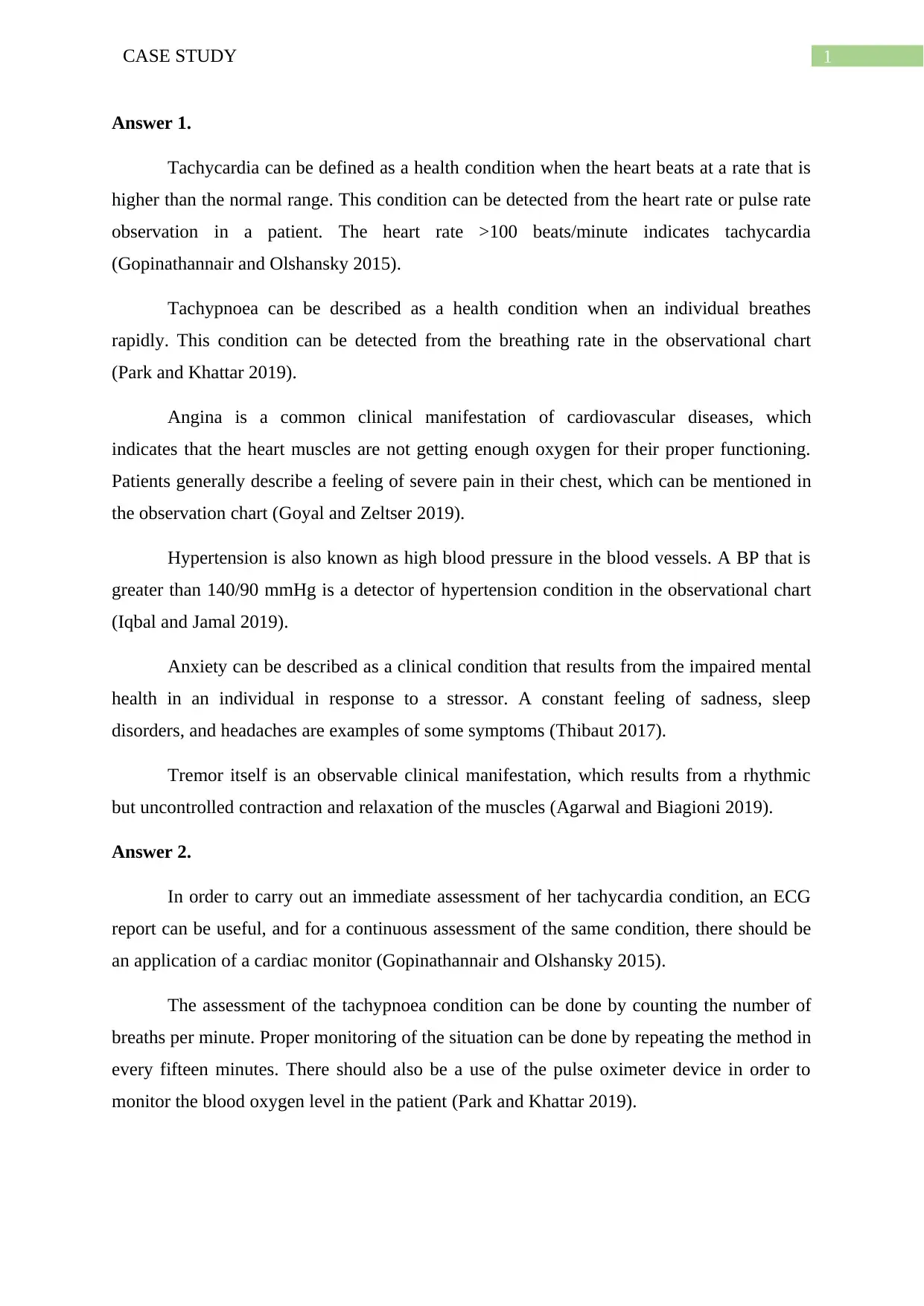
1CASE STUDY
Answer 1.
Tachycardia can be defined as a health condition when the heart beats at a rate that is
higher than the normal range. This condition can be detected from the heart rate or pulse rate
observation in a patient. The heart rate >100 beats/minute indicates tachycardia
(Gopinathannair and Olshansky 2015).
Tachypnoea can be described as a health condition when an individual breathes
rapidly. This condition can be detected from the breathing rate in the observational chart
(Park and Khattar 2019).
Angina is a common clinical manifestation of cardiovascular diseases, which
indicates that the heart muscles are not getting enough oxygen for their proper functioning.
Patients generally describe a feeling of severe pain in their chest, which can be mentioned in
the observation chart (Goyal and Zeltser 2019).
Hypertension is also known as high blood pressure in the blood vessels. A BP that is
greater than 140/90 mmHg is a detector of hypertension condition in the observational chart
(Iqbal and Jamal 2019).
Anxiety can be described as a clinical condition that results from the impaired mental
health in an individual in response to a stressor. A constant feeling of sadness, sleep
disorders, and headaches are examples of some symptoms (Thibaut 2017).
Tremor itself is an observable clinical manifestation, which results from a rhythmic
but uncontrolled contraction and relaxation of the muscles (Agarwal and Biagioni 2019).
Answer 2.
In order to carry out an immediate assessment of her tachycardia condition, an ECG
report can be useful, and for a continuous assessment of the same condition, there should be
an application of a cardiac monitor (Gopinathannair and Olshansky 2015).
The assessment of the tachypnoea condition can be done by counting the number of
breaths per minute. Proper monitoring of the situation can be done by repeating the method in
every fifteen minutes. There should also be a use of the pulse oximeter device in order to
monitor the blood oxygen level in the patient (Park and Khattar 2019).
Answer 1.
Tachycardia can be defined as a health condition when the heart beats at a rate that is
higher than the normal range. This condition can be detected from the heart rate or pulse rate
observation in a patient. The heart rate >100 beats/minute indicates tachycardia
(Gopinathannair and Olshansky 2015).
Tachypnoea can be described as a health condition when an individual breathes
rapidly. This condition can be detected from the breathing rate in the observational chart
(Park and Khattar 2019).
Angina is a common clinical manifestation of cardiovascular diseases, which
indicates that the heart muscles are not getting enough oxygen for their proper functioning.
Patients generally describe a feeling of severe pain in their chest, which can be mentioned in
the observation chart (Goyal and Zeltser 2019).
Hypertension is also known as high blood pressure in the blood vessels. A BP that is
greater than 140/90 mmHg is a detector of hypertension condition in the observational chart
(Iqbal and Jamal 2019).
Anxiety can be described as a clinical condition that results from the impaired mental
health in an individual in response to a stressor. A constant feeling of sadness, sleep
disorders, and headaches are examples of some symptoms (Thibaut 2017).
Tremor itself is an observable clinical manifestation, which results from a rhythmic
but uncontrolled contraction and relaxation of the muscles (Agarwal and Biagioni 2019).
Answer 2.
In order to carry out an immediate assessment of her tachycardia condition, an ECG
report can be useful, and for a continuous assessment of the same condition, there should be
an application of a cardiac monitor (Gopinathannair and Olshansky 2015).
The assessment of the tachypnoea condition can be done by counting the number of
breaths per minute. Proper monitoring of the situation can be done by repeating the method in
every fifteen minutes. There should also be a use of the pulse oximeter device in order to
monitor the blood oxygen level in the patient (Park and Khattar 2019).
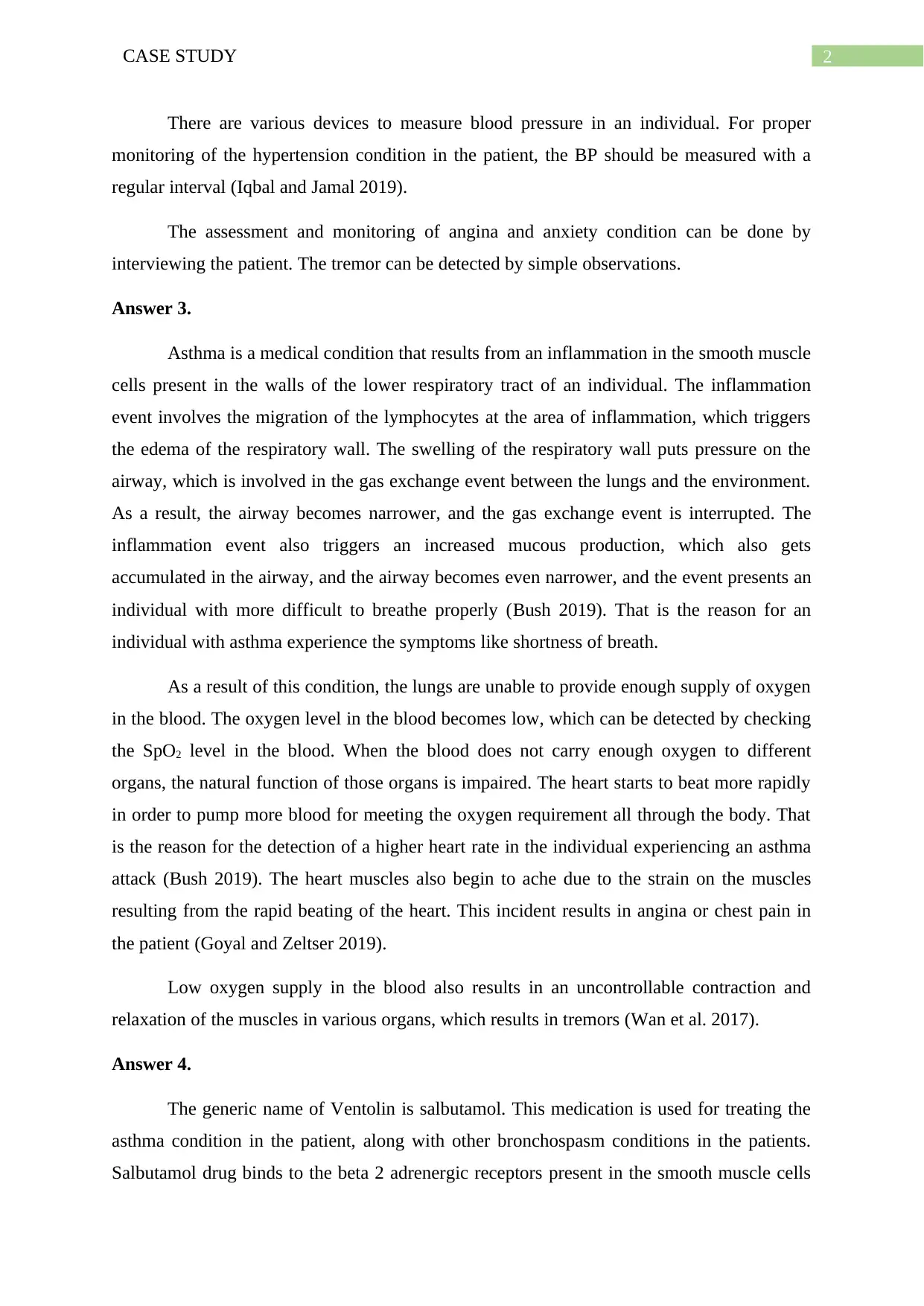
2CASE STUDY
There are various devices to measure blood pressure in an individual. For proper
monitoring of the hypertension condition in the patient, the BP should be measured with a
regular interval (Iqbal and Jamal 2019).
The assessment and monitoring of angina and anxiety condition can be done by
interviewing the patient. The tremor can be detected by simple observations.
Answer 3.
Asthma is a medical condition that results from an inflammation in the smooth muscle
cells present in the walls of the lower respiratory tract of an individual. The inflammation
event involves the migration of the lymphocytes at the area of inflammation, which triggers
the edema of the respiratory wall. The swelling of the respiratory wall puts pressure on the
airway, which is involved in the gas exchange event between the lungs and the environment.
As a result, the airway becomes narrower, and the gas exchange event is interrupted. The
inflammation event also triggers an increased mucous production, which also gets
accumulated in the airway, and the airway becomes even narrower, and the event presents an
individual with more difficult to breathe properly (Bush 2019). That is the reason for an
individual with asthma experience the symptoms like shortness of breath.
As a result of this condition, the lungs are unable to provide enough supply of oxygen
in the blood. The oxygen level in the blood becomes low, which can be detected by checking
the SpO2 level in the blood. When the blood does not carry enough oxygen to different
organs, the natural function of those organs is impaired. The heart starts to beat more rapidly
in order to pump more blood for meeting the oxygen requirement all through the body. That
is the reason for the detection of a higher heart rate in the individual experiencing an asthma
attack (Bush 2019). The heart muscles also begin to ache due to the strain on the muscles
resulting from the rapid beating of the heart. This incident results in angina or chest pain in
the patient (Goyal and Zeltser 2019).
Low oxygen supply in the blood also results in an uncontrollable contraction and
relaxation of the muscles in various organs, which results in tremors (Wan et al. 2017).
Answer 4.
The generic name of Ventolin is salbutamol. This medication is used for treating the
asthma condition in the patient, along with other bronchospasm conditions in the patients.
Salbutamol drug binds to the beta 2 adrenergic receptors present in the smooth muscle cells
There are various devices to measure blood pressure in an individual. For proper
monitoring of the hypertension condition in the patient, the BP should be measured with a
regular interval (Iqbal and Jamal 2019).
The assessment and monitoring of angina and anxiety condition can be done by
interviewing the patient. The tremor can be detected by simple observations.
Answer 3.
Asthma is a medical condition that results from an inflammation in the smooth muscle
cells present in the walls of the lower respiratory tract of an individual. The inflammation
event involves the migration of the lymphocytes at the area of inflammation, which triggers
the edema of the respiratory wall. The swelling of the respiratory wall puts pressure on the
airway, which is involved in the gas exchange event between the lungs and the environment.
As a result, the airway becomes narrower, and the gas exchange event is interrupted. The
inflammation event also triggers an increased mucous production, which also gets
accumulated in the airway, and the airway becomes even narrower, and the event presents an
individual with more difficult to breathe properly (Bush 2019). That is the reason for an
individual with asthma experience the symptoms like shortness of breath.
As a result of this condition, the lungs are unable to provide enough supply of oxygen
in the blood. The oxygen level in the blood becomes low, which can be detected by checking
the SpO2 level in the blood. When the blood does not carry enough oxygen to different
organs, the natural function of those organs is impaired. The heart starts to beat more rapidly
in order to pump more blood for meeting the oxygen requirement all through the body. That
is the reason for the detection of a higher heart rate in the individual experiencing an asthma
attack (Bush 2019). The heart muscles also begin to ache due to the strain on the muscles
resulting from the rapid beating of the heart. This incident results in angina or chest pain in
the patient (Goyal and Zeltser 2019).
Low oxygen supply in the blood also results in an uncontrollable contraction and
relaxation of the muscles in various organs, which results in tremors (Wan et al. 2017).
Answer 4.
The generic name of Ventolin is salbutamol. This medication is used for treating the
asthma condition in the patient, along with other bronchospasm conditions in the patients.
Salbutamol drug binds to the beta 2 adrenergic receptors present in the smooth muscle cells
⊘ This is a preview!⊘
Do you want full access?
Subscribe today to unlock all pages.

Trusted by 1+ million students worldwide
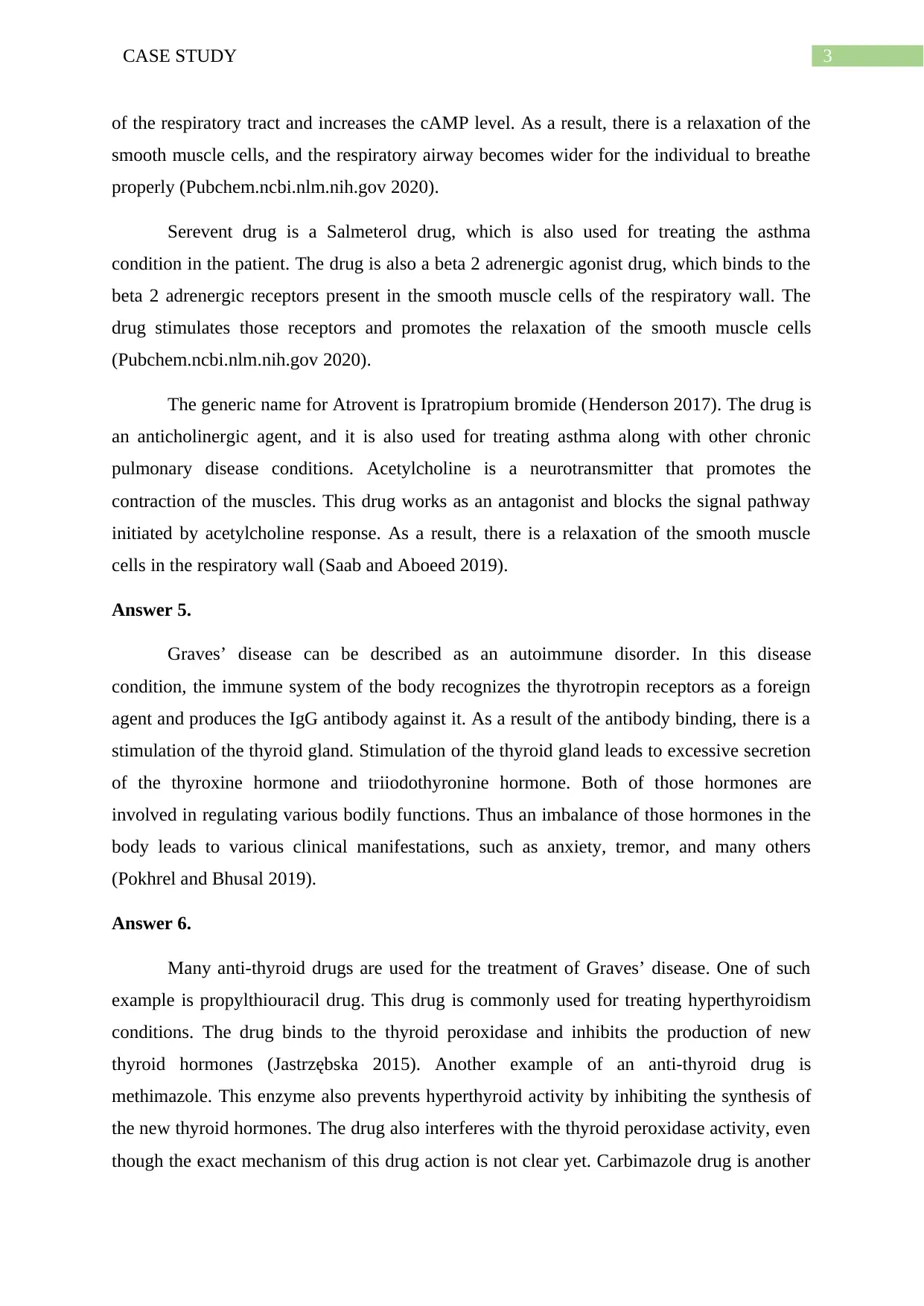
3CASE STUDY
of the respiratory tract and increases the cAMP level. As a result, there is a relaxation of the
smooth muscle cells, and the respiratory airway becomes wider for the individual to breathe
properly (Pubchem.ncbi.nlm.nih.gov 2020).
Serevent drug is a Salmeterol drug, which is also used for treating the asthma
condition in the patient. The drug is also a beta 2 adrenergic agonist drug, which binds to the
beta 2 adrenergic receptors present in the smooth muscle cells of the respiratory wall. The
drug stimulates those receptors and promotes the relaxation of the smooth muscle cells
(Pubchem.ncbi.nlm.nih.gov 2020).
The generic name for Atrovent is Ipratropium bromide (Henderson 2017). The drug is
an anticholinergic agent, and it is also used for treating asthma along with other chronic
pulmonary disease conditions. Acetylcholine is a neurotransmitter that promotes the
contraction of the muscles. This drug works as an antagonist and blocks the signal pathway
initiated by acetylcholine response. As a result, there is a relaxation of the smooth muscle
cells in the respiratory wall (Saab and Aboeed 2019).
Answer 5.
Graves’ disease can be described as an autoimmune disorder. In this disease
condition, the immune system of the body recognizes the thyrotropin receptors as a foreign
agent and produces the IgG antibody against it. As a result of the antibody binding, there is a
stimulation of the thyroid gland. Stimulation of the thyroid gland leads to excessive secretion
of the thyroxine hormone and triiodothyronine hormone. Both of those hormones are
involved in regulating various bodily functions. Thus an imbalance of those hormones in the
body leads to various clinical manifestations, such as anxiety, tremor, and many others
(Pokhrel and Bhusal 2019).
Answer 6.
Many anti-thyroid drugs are used for the treatment of Graves’ disease. One of such
example is propylthiouracil drug. This drug is commonly used for treating hyperthyroidism
conditions. The drug binds to the thyroid peroxidase and inhibits the production of new
thyroid hormones (Jastrzębska 2015). Another example of an anti-thyroid drug is
methimazole. This enzyme also prevents hyperthyroid activity by inhibiting the synthesis of
the new thyroid hormones. The drug also interferes with the thyroid peroxidase activity, even
though the exact mechanism of this drug action is not clear yet. Carbimazole drug is another
of the respiratory tract and increases the cAMP level. As a result, there is a relaxation of the
smooth muscle cells, and the respiratory airway becomes wider for the individual to breathe
properly (Pubchem.ncbi.nlm.nih.gov 2020).
Serevent drug is a Salmeterol drug, which is also used for treating the asthma
condition in the patient. The drug is also a beta 2 adrenergic agonist drug, which binds to the
beta 2 adrenergic receptors present in the smooth muscle cells of the respiratory wall. The
drug stimulates those receptors and promotes the relaxation of the smooth muscle cells
(Pubchem.ncbi.nlm.nih.gov 2020).
The generic name for Atrovent is Ipratropium bromide (Henderson 2017). The drug is
an anticholinergic agent, and it is also used for treating asthma along with other chronic
pulmonary disease conditions. Acetylcholine is a neurotransmitter that promotes the
contraction of the muscles. This drug works as an antagonist and blocks the signal pathway
initiated by acetylcholine response. As a result, there is a relaxation of the smooth muscle
cells in the respiratory wall (Saab and Aboeed 2019).
Answer 5.
Graves’ disease can be described as an autoimmune disorder. In this disease
condition, the immune system of the body recognizes the thyrotropin receptors as a foreign
agent and produces the IgG antibody against it. As a result of the antibody binding, there is a
stimulation of the thyroid gland. Stimulation of the thyroid gland leads to excessive secretion
of the thyroxine hormone and triiodothyronine hormone. Both of those hormones are
involved in regulating various bodily functions. Thus an imbalance of those hormones in the
body leads to various clinical manifestations, such as anxiety, tremor, and many others
(Pokhrel and Bhusal 2019).
Answer 6.
Many anti-thyroid drugs are used for the treatment of Graves’ disease. One of such
example is propylthiouracil drug. This drug is commonly used for treating hyperthyroidism
conditions. The drug binds to the thyroid peroxidase and inhibits the production of new
thyroid hormones (Jastrzębska 2015). Another example of an anti-thyroid drug is
methimazole. This enzyme also prevents hyperthyroid activity by inhibiting the synthesis of
the new thyroid hormones. The drug also interferes with the thyroid peroxidase activity, even
though the exact mechanism of this drug action is not clear yet. Carbimazole drug is another
Paraphrase This Document
Need a fresh take? Get an instant paraphrase of this document with our AI Paraphraser
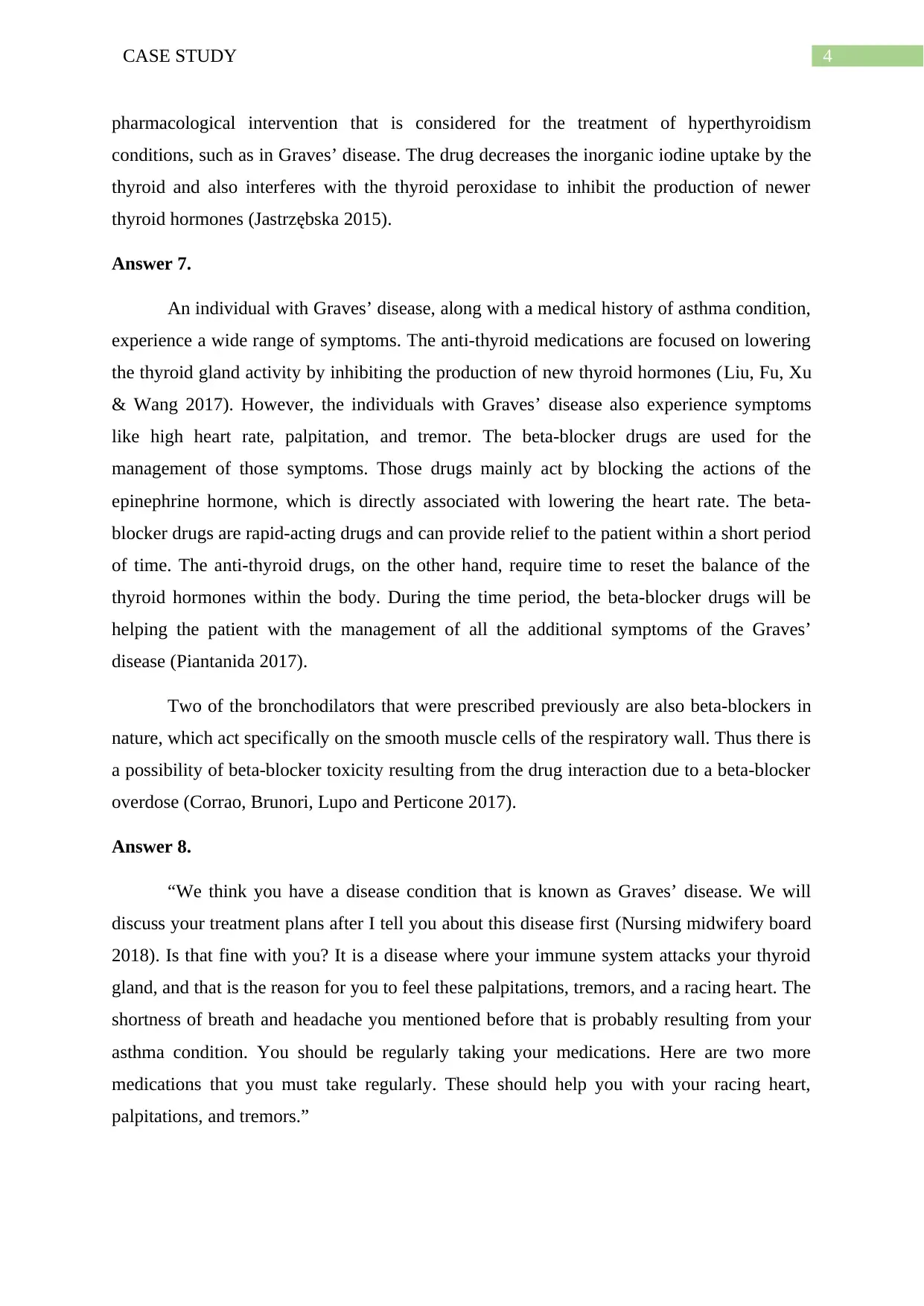
4CASE STUDY
pharmacological intervention that is considered for the treatment of hyperthyroidism
conditions, such as in Graves’ disease. The drug decreases the inorganic iodine uptake by the
thyroid and also interferes with the thyroid peroxidase to inhibit the production of newer
thyroid hormones (Jastrzębska 2015).
Answer 7.
An individual with Graves’ disease, along with a medical history of asthma condition,
experience a wide range of symptoms. The anti-thyroid medications are focused on lowering
the thyroid gland activity by inhibiting the production of new thyroid hormones (Liu, Fu, Xu
& Wang 2017). However, the individuals with Graves’ disease also experience symptoms
like high heart rate, palpitation, and tremor. The beta-blocker drugs are used for the
management of those symptoms. Those drugs mainly act by blocking the actions of the
epinephrine hormone, which is directly associated with lowering the heart rate. The beta-
blocker drugs are rapid-acting drugs and can provide relief to the patient within a short period
of time. The anti-thyroid drugs, on the other hand, require time to reset the balance of the
thyroid hormones within the body. During the time period, the beta-blocker drugs will be
helping the patient with the management of all the additional symptoms of the Graves’
disease (Piantanida 2017).
Two of the bronchodilators that were prescribed previously are also beta-blockers in
nature, which act specifically on the smooth muscle cells of the respiratory wall. Thus there is
a possibility of beta-blocker toxicity resulting from the drug interaction due to a beta-blocker
overdose (Corrao, Brunori, Lupo and Perticone 2017).
Answer 8.
“We think you have a disease condition that is known as Graves’ disease. We will
discuss your treatment plans after I tell you about this disease first (Nursing midwifery board
2018). Is that fine with you? It is a disease where your immune system attacks your thyroid
gland, and that is the reason for you to feel these palpitations, tremors, and a racing heart. The
shortness of breath and headache you mentioned before that is probably resulting from your
asthma condition. You should be regularly taking your medications. Here are two more
medications that you must take regularly. These should help you with your racing heart,
palpitations, and tremors.”
pharmacological intervention that is considered for the treatment of hyperthyroidism
conditions, such as in Graves’ disease. The drug decreases the inorganic iodine uptake by the
thyroid and also interferes with the thyroid peroxidase to inhibit the production of newer
thyroid hormones (Jastrzębska 2015).
Answer 7.
An individual with Graves’ disease, along with a medical history of asthma condition,
experience a wide range of symptoms. The anti-thyroid medications are focused on lowering
the thyroid gland activity by inhibiting the production of new thyroid hormones (Liu, Fu, Xu
& Wang 2017). However, the individuals with Graves’ disease also experience symptoms
like high heart rate, palpitation, and tremor. The beta-blocker drugs are used for the
management of those symptoms. Those drugs mainly act by blocking the actions of the
epinephrine hormone, which is directly associated with lowering the heart rate. The beta-
blocker drugs are rapid-acting drugs and can provide relief to the patient within a short period
of time. The anti-thyroid drugs, on the other hand, require time to reset the balance of the
thyroid hormones within the body. During the time period, the beta-blocker drugs will be
helping the patient with the management of all the additional symptoms of the Graves’
disease (Piantanida 2017).
Two of the bronchodilators that were prescribed previously are also beta-blockers in
nature, which act specifically on the smooth muscle cells of the respiratory wall. Thus there is
a possibility of beta-blocker toxicity resulting from the drug interaction due to a beta-blocker
overdose (Corrao, Brunori, Lupo and Perticone 2017).
Answer 8.
“We think you have a disease condition that is known as Graves’ disease. We will
discuss your treatment plans after I tell you about this disease first (Nursing midwifery board
2018). Is that fine with you? It is a disease where your immune system attacks your thyroid
gland, and that is the reason for you to feel these palpitations, tremors, and a racing heart. The
shortness of breath and headache you mentioned before that is probably resulting from your
asthma condition. You should be regularly taking your medications. Here are two more
medications that you must take regularly. These should help you with your racing heart,
palpitations, and tremors.”

5CASE STUDY
“Both of your conditions are actually risky for you if you decide to conceive. Asthma
and Graves’ disease both can get worse for you. You might experience more severe
symptoms compared to what you are experiencing now. But if you continue to follow your
prescription and take these drugs regularly, that should help you. These drugs are completely
safe for your pregnancy. But once you are sure of your pregnancy, you should consult with a
doctor. Don’t forget to show him or her your prescriptions. Have a good day.”
“Both of your conditions are actually risky for you if you decide to conceive. Asthma
and Graves’ disease both can get worse for you. You might experience more severe
symptoms compared to what you are experiencing now. But if you continue to follow your
prescription and take these drugs regularly, that should help you. These drugs are completely
safe for your pregnancy. But once you are sure of your pregnancy, you should consult with a
doctor. Don’t forget to show him or her your prescriptions. Have a good day.”
⊘ This is a preview!⊘
Do you want full access?
Subscribe today to unlock all pages.

Trusted by 1+ million students worldwide
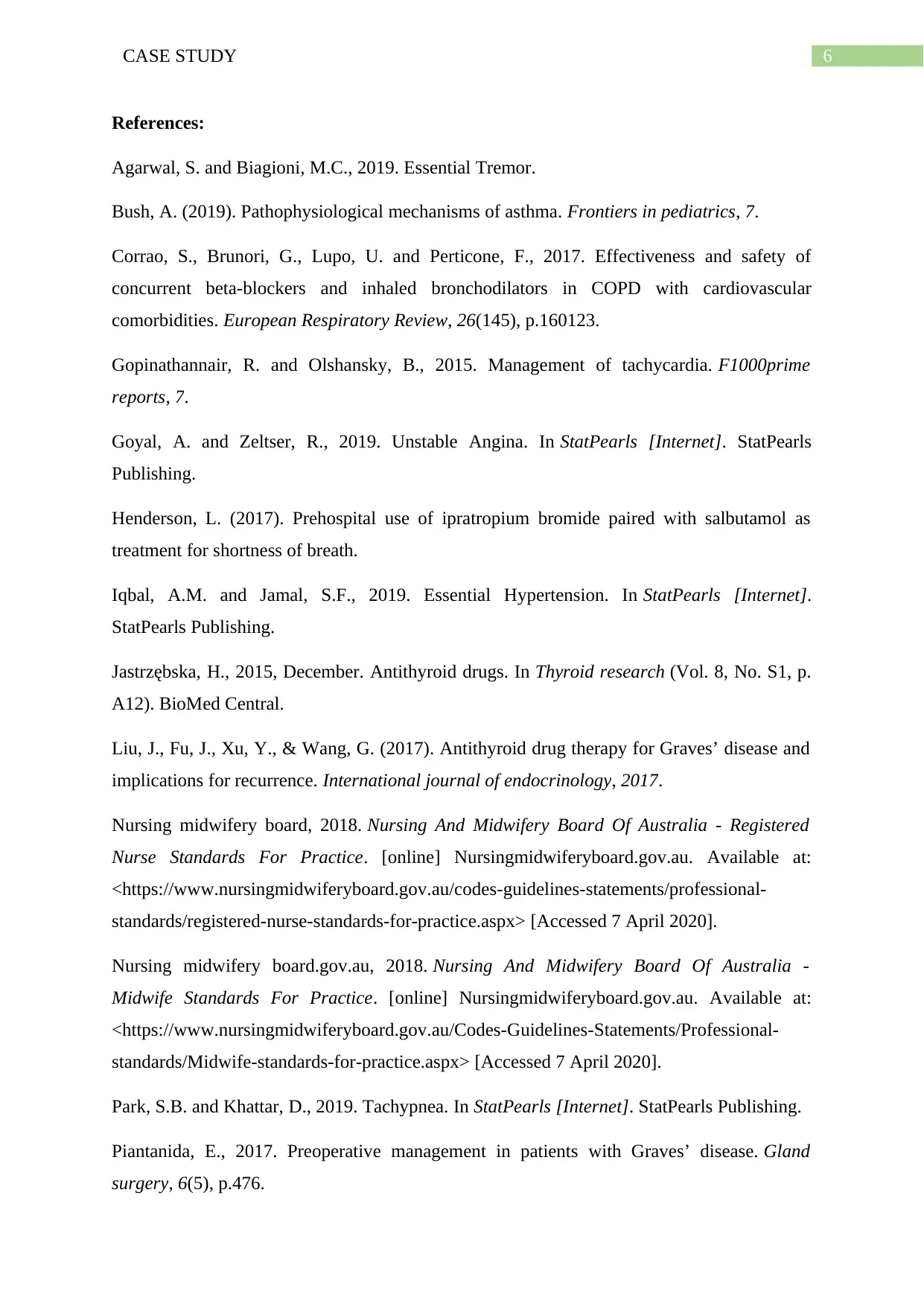
6CASE STUDY
References:
Agarwal, S. and Biagioni, M.C., 2019. Essential Tremor.
Bush, A. (2019). Pathophysiological mechanisms of asthma. Frontiers in pediatrics, 7.
Corrao, S., Brunori, G., Lupo, U. and Perticone, F., 2017. Effectiveness and safety of
concurrent beta-blockers and inhaled bronchodilators in COPD with cardiovascular
comorbidities. European Respiratory Review, 26(145), p.160123.
Gopinathannair, R. and Olshansky, B., 2015. Management of tachycardia. F1000prime
reports, 7.
Goyal, A. and Zeltser, R., 2019. Unstable Angina. In StatPearls [Internet]. StatPearls
Publishing.
Henderson, L. (2017). Prehospital use of ipratropium bromide paired with salbutamol as
treatment for shortness of breath.
Iqbal, A.M. and Jamal, S.F., 2019. Essential Hypertension. In StatPearls [Internet].
StatPearls Publishing.
Jastrzębska, H., 2015, December. Antithyroid drugs. In Thyroid research (Vol. 8, No. S1, p.
A12). BioMed Central.
Liu, J., Fu, J., Xu, Y., & Wang, G. (2017). Antithyroid drug therapy for Graves’ disease and
implications for recurrence. International journal of endocrinology, 2017.
Nursing midwifery board, 2018. Nursing And Midwifery Board Of Australia - Registered
Nurse Standards For Practice. [online] Nursingmidwiferyboard.gov.au. Available at:
<https://www.nursingmidwiferyboard.gov.au/codes-guidelines-statements/professional-
standards/registered-nurse-standards-for-practice.aspx> [Accessed 7 April 2020].
Nursing midwifery board.gov.au, 2018. Nursing And Midwifery Board Of Australia -
Midwife Standards For Practice. [online] Nursingmidwiferyboard.gov.au. Available at:
<https://www.nursingmidwiferyboard.gov.au/Codes-Guidelines-Statements/Professional-
standards/Midwife-standards-for-practice.aspx> [Accessed 7 April 2020].
Park, S.B. and Khattar, D., 2019. Tachypnea. In StatPearls [Internet]. StatPearls Publishing.
Piantanida, E., 2017. Preoperative management in patients with Graves’ disease. Gland
surgery, 6(5), p.476.
References:
Agarwal, S. and Biagioni, M.C., 2019. Essential Tremor.
Bush, A. (2019). Pathophysiological mechanisms of asthma. Frontiers in pediatrics, 7.
Corrao, S., Brunori, G., Lupo, U. and Perticone, F., 2017. Effectiveness and safety of
concurrent beta-blockers and inhaled bronchodilators in COPD with cardiovascular
comorbidities. European Respiratory Review, 26(145), p.160123.
Gopinathannair, R. and Olshansky, B., 2015. Management of tachycardia. F1000prime
reports, 7.
Goyal, A. and Zeltser, R., 2019. Unstable Angina. In StatPearls [Internet]. StatPearls
Publishing.
Henderson, L. (2017). Prehospital use of ipratropium bromide paired with salbutamol as
treatment for shortness of breath.
Iqbal, A.M. and Jamal, S.F., 2019. Essential Hypertension. In StatPearls [Internet].
StatPearls Publishing.
Jastrzębska, H., 2015, December. Antithyroid drugs. In Thyroid research (Vol. 8, No. S1, p.
A12). BioMed Central.
Liu, J., Fu, J., Xu, Y., & Wang, G. (2017). Antithyroid drug therapy for Graves’ disease and
implications for recurrence. International journal of endocrinology, 2017.
Nursing midwifery board, 2018. Nursing And Midwifery Board Of Australia - Registered
Nurse Standards For Practice. [online] Nursingmidwiferyboard.gov.au. Available at:
<https://www.nursingmidwiferyboard.gov.au/codes-guidelines-statements/professional-
standards/registered-nurse-standards-for-practice.aspx> [Accessed 7 April 2020].
Nursing midwifery board.gov.au, 2018. Nursing And Midwifery Board Of Australia -
Midwife Standards For Practice. [online] Nursingmidwiferyboard.gov.au. Available at:
<https://www.nursingmidwiferyboard.gov.au/Codes-Guidelines-Statements/Professional-
standards/Midwife-standards-for-practice.aspx> [Accessed 7 April 2020].
Park, S.B. and Khattar, D., 2019. Tachypnea. In StatPearls [Internet]. StatPearls Publishing.
Piantanida, E., 2017. Preoperative management in patients with Graves’ disease. Gland
surgery, 6(5), p.476.
Paraphrase This Document
Need a fresh take? Get an instant paraphrase of this document with our AI Paraphraser
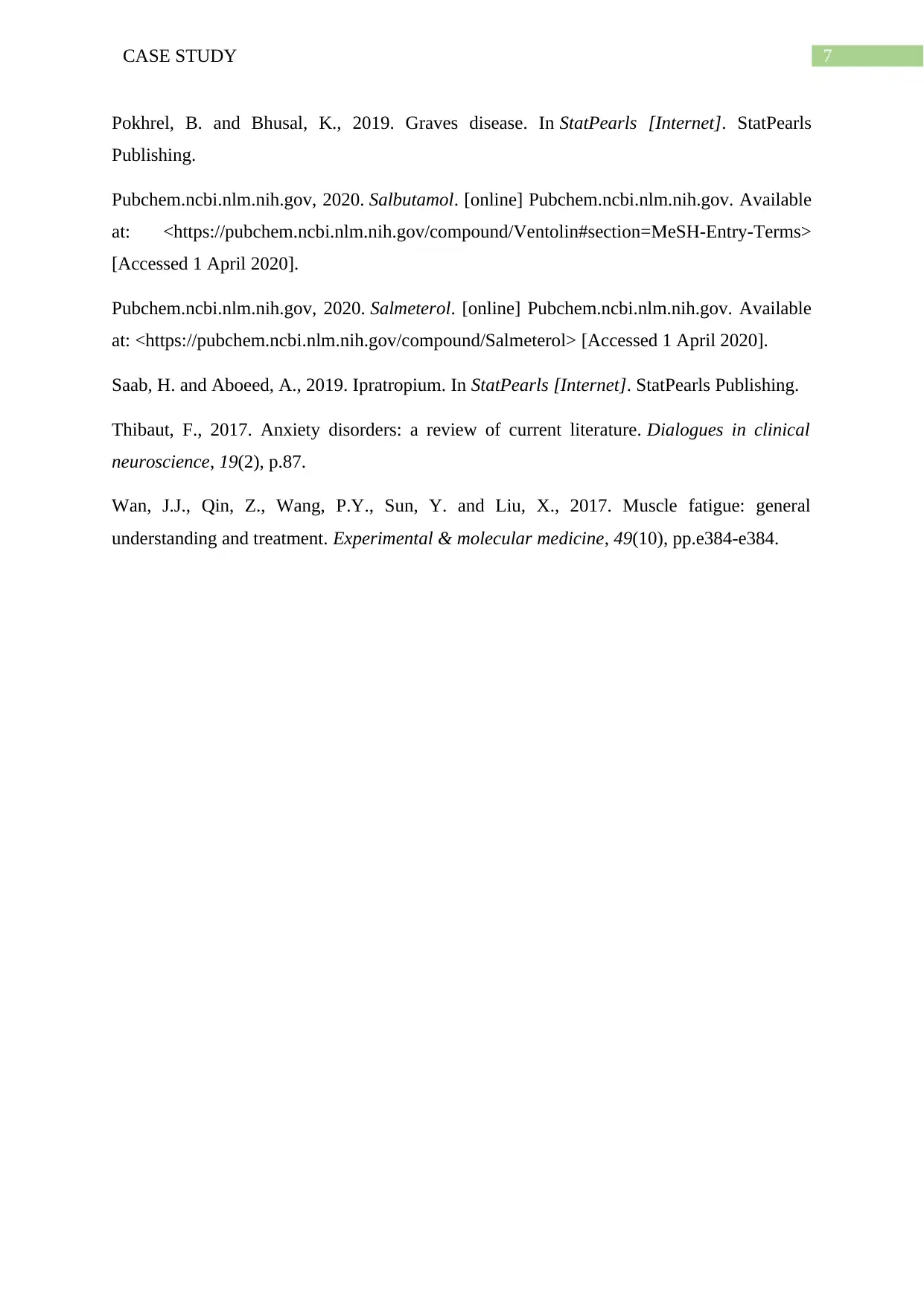
7CASE STUDY
Pokhrel, B. and Bhusal, K., 2019. Graves disease. In StatPearls [Internet]. StatPearls
Publishing.
Pubchem.ncbi.nlm.nih.gov, 2020. Salbutamol. [online] Pubchem.ncbi.nlm.nih.gov. Available
at: <https://pubchem.ncbi.nlm.nih.gov/compound/Ventolin#section=MeSH-Entry-Terms>
[Accessed 1 April 2020].
Pubchem.ncbi.nlm.nih.gov, 2020. Salmeterol. [online] Pubchem.ncbi.nlm.nih.gov. Available
at: <https://pubchem.ncbi.nlm.nih.gov/compound/Salmeterol> [Accessed 1 April 2020].
Saab, H. and Aboeed, A., 2019. Ipratropium. In StatPearls [Internet]. StatPearls Publishing.
Thibaut, F., 2017. Anxiety disorders: a review of current literature. Dialogues in clinical
neuroscience, 19(2), p.87.
Wan, J.J., Qin, Z., Wang, P.Y., Sun, Y. and Liu, X., 2017. Muscle fatigue: general
understanding and treatment. Experimental & molecular medicine, 49(10), pp.e384-e384.
Pokhrel, B. and Bhusal, K., 2019. Graves disease. In StatPearls [Internet]. StatPearls
Publishing.
Pubchem.ncbi.nlm.nih.gov, 2020. Salbutamol. [online] Pubchem.ncbi.nlm.nih.gov. Available
at: <https://pubchem.ncbi.nlm.nih.gov/compound/Ventolin#section=MeSH-Entry-Terms>
[Accessed 1 April 2020].
Pubchem.ncbi.nlm.nih.gov, 2020. Salmeterol. [online] Pubchem.ncbi.nlm.nih.gov. Available
at: <https://pubchem.ncbi.nlm.nih.gov/compound/Salmeterol> [Accessed 1 April 2020].
Saab, H. and Aboeed, A., 2019. Ipratropium. In StatPearls [Internet]. StatPearls Publishing.
Thibaut, F., 2017. Anxiety disorders: a review of current literature. Dialogues in clinical
neuroscience, 19(2), p.87.
Wan, J.J., Qin, Z., Wang, P.Y., Sun, Y. and Liu, X., 2017. Muscle fatigue: general
understanding and treatment. Experimental & molecular medicine, 49(10), pp.e384-e384.
1 out of 8
Related Documents
Your All-in-One AI-Powered Toolkit for Academic Success.
+13062052269
info@desklib.com
Available 24*7 on WhatsApp / Email
![[object Object]](/_next/static/media/star-bottom.7253800d.svg)
Unlock your academic potential
Copyright © 2020–2025 A2Z Services. All Rights Reserved. Developed and managed by ZUCOL.





